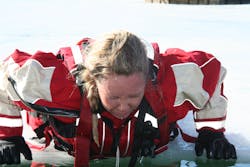The average woman feels the effects of cold temperatures sooner and at a much faster rate than the average man does. For example, in the same room, a man can feel comfortable, and a woman can feel cold. Numerous obvious and not so obvious factors contribute to this: fat distribution, internal functions, metabolism, muscle mass, perception of temperature and smaller size, to name a few.
A woman’s body produces less heat than a man’s body does. Women on average are smaller than men and have less muscle and more fat. Men naturally having more muscle equates to a higher metabolic rate and more heat than women, in general. Most women’s lower and slower metabolism than that of most men contributes to the idea that women tend to be and feel colder than men.
Women vasoconstrict at a much faster rate in cold temperatures than men do. This vasoconstriction moves the body’s blood to the core and away from the skin’s surface to keep vital organs warm, thus making the skin and extremities feel colder.
Women’s hands and feet typically are cooler than men’s, sometimes as much as 3 degrees Fahrenheit cooler, so women’s hands and feet are the first parts of their body to get even colder, which increases susceptibility to frost nip or frost bite. On average, a man will last a lot longer in the same temperature before he perceives the effects of the cold on his hands and feet.
Furthermore, even though a woman’s body in an icy water situation might be internally warm and she might not be in a stage of severe hypothermia, she most likely has lost feeling and dexterity in her hands, arms, feet and legs. Such a circumstance makes it potentially impossible for her to self-extricate or to even hold onto the ice shelf until help reaches her.
As an ice rescue technician, staying warm and maintaining dexterity are bottom-line requirements.
Adjustments
Considering that women are at a physiological disadvantage when it comes to extremely cold temperatures compared with men, women rescuers must be aware of these limitations and adjust accordingly. An example of this is to execute a faster, more calculated rescue response. The faster, more efficient rescue will offset the time that’s spent in the icy cold environment.
This is accomplished by putting an even greater emphasis than usual on taking charge of the situation by communicating with authority to victims, thereby getting their attention. It’s even more imperative that woman rescuers speak loudly and clearly to let a victim know exactly what that individual must do and how that individual can help the woman rescuer accomplish a successful rescue outcome.
Also, the onus on women rescuers to preplan each aspect of a rescue, using best practices, is increased compared with when a responder who is a man effects a rescue. Best practices for rescuers include trying not to splash the victim or themselves in the face, because this could increase the chance of the reflexive gasp response and might restrict the breathing.
Lightweight reach pole
Given the possibility of a woman rescuer’s smaller stature, she might have a short arm length. Such a circumstance would inhibit her reach as compared with the typical male rescuer. Thus, she might have to use tools that a rescuer who is a man might not require, to help to overcome her limitation.
Although a reach pole is an essential tool to have as a rescuer no matter the size of the individual, its importance is increased when a rescuer has a short reach. Therefore, significant strength and light weight of the reach pole is vital.
Carbon fiber construction of a reach pole provides strong but light performance, which is essential for a rescuer who is smaller and can increase a woman rescuer’s effectiveness in a cold water/ice rescue situation.
Compared with their typical male counterparts, most women rescuers lose their strength more quickly when it comes to ice and cold-water rescue. This, too, is where a carbon fiber reach pole’s importance emerges. When a woman rescuer falls through the ice, she can use such a reach pole more effectively than a heavier reach pole to self-extricate by laying the pole horizontally on the ice or snow and pulling herself out of the icy water to safety.
Attachments that are designed to be used with a reach pole increase the probability of rescue success, too.
Of course, it’s important for any rescuer to get trained to use a reach pole or any rescue tool to its greatest potential.
PPE
Another factor that puts many women rescuers at a disadvantage compared with typical male counterparts is the size range, or lack thereof, of PPE. Very few options in ice rescue suits fit smaller first responders. Often, the suits that a department carries on its truck are suitable only for a larger man. Typically, these suits are touted as one-size-fits-all. However, when a woman rescuer wears one of the suits, it often is too big for her.
Most women have much smaller feet than what’s typically accommodated on ice rescue suits: size 11 or 12 boots that are permanently installed on the suit.
Another limiting factor is the attached glove size. It usually is large, and most women have smaller hands compared with men. This large glove size often limits a woman’s dexterity. Of course, dexterity is required when managing ropes and manipulating carabiners. Ill-fitting gloves can get caught in carabiners and in rings and might prevent a smaller rescuer from holding onto a victim and administering proper care.
Women rescuers can do numerous things to offset the disadvantages of the PPE that’s available to them. In the case of an ice rescue suit that’s too big, a woman might want to use thigh straps to decrease the size of the suit. When the feet are too big, duct taping the ankles to the boots can hold the boots in place. Fins also can help to hold boots in place—as well as, of course, helping to propel rescuers should they find themselves in open water. Stainless-steel fin straps might be the best option.
Gloves likely must be taped at the wrist, so they don’t become an impediment during the rescue.
Obviously, it’s best to have a department invest in an ice rescue suit that fits the particular female responder. Then, the overall size of suit can be matched with properly fitting gloves and boots.
Women rescuer advantages
Although a woman rescuer’s light weight and small size can be disadvantages, they also can be great advantages.
One of the first rules in understanding ice rescue is this: The only reason that a person fell through the ice is that the ice was too thin to support the weight of the person. With this fact in mind, we often advocate for the ice rescue technician who weighs the least to be deployed onto compromised ice to perform a rescue. This technician typically is a woman who weighs less than her male counterparts weigh.
In addition, although most women have less muscle mass than men have, women usually are more buoyant.
Increase chance to succeed
Women face several known disadvantages in an ice rescue response. Being aware of these factors, while using proper rescue practices and tools, can offset these disadvantages, thereby providing them with the opportunity to have a successful rescue response.







